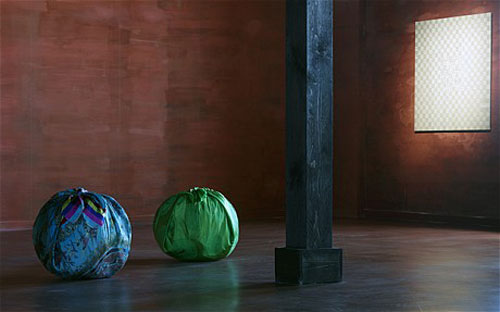On until the 25th April at the Miro Foundation is Sonar, an exhibition of the experimental work of German artist Michael Sailstorfer. The interesting new show addresses the question which preoccupied the artist and which shaped his work: what is a sculpture?

Sonar, as the name suggests, is an experimental exhibition based on sound, in which a piece of glass is broken for acoustic effect. In order to make this effect visible, Sailstorfer constructs a room from wood, with one window, whose glass absorbs high frequency sound via a generator installed on the inside. The final smashing of the glass, which is the climax of the show, is shown on a video inside of the room, and can only been seen through the window frame of the broken glass.
Michael Sailstorfer plays with concepts that he has derived from literature and cinema, transferring them into experimental installations. The Sonar piece is inspired by a character in the novel by Günter Grass, which was adapted for the screen by Volker Schlöndorff. The narrative revolves around Oskar Matzerath, a young boy who decides to stop growing at three years old, and develops a talent for breaking glass, using sounds created by playing his tambourine. The child symbolises the rupture of purity at the time of Hitler´s rise to power, and the desperation of a world without hope.
Another of the inspirations at play in this work is the interesting performance Window Blowout in 1976 from North American vanguard artist Gordon Matta-Clark, son of surrealist painter Roberto Matta and Anne Clark, which involved shooting at glass in an abandoned building in Bronx, New York – reflecting a disdain for urban decadence and social segregation.
Sailstorfer´s work is characterised by a strong sense of the absurd, expressed through interesting installations which use every day objects in order to explore existential concepts. His definition of his art is summed up in the phrase that he wants to create art which “comes less from the head than from the stomach,” – reflecting his freedom to create pieces which are more instinctively poetic than just intellectual concepts.
Sailstorfer is fascinated by transformation, adapting and dismantling different objects in order to reconstruct whole new audio-based structures, which have lost their previous functions, but possess a unique kind of harmony.
His obsession with sound as a sculptural mechanism can be detected in many of his works – which use natural objects, and machinery which emit different sounds as an integral part of the sculpture as a whole.
For more information: http://www.fundaciomiro-bcn.org/espai13_actual.php?exposicion=3048&idioma=6#expocicle
 Nancy Guzman
Nancy Guzman
Go and discover this interesting work if you are staying Barcelona accommodation . You´ll leave with a strong sense of the emotional effect that a piece of art can have.

 English
English Translated by: Poppy
Translated by: Poppy

